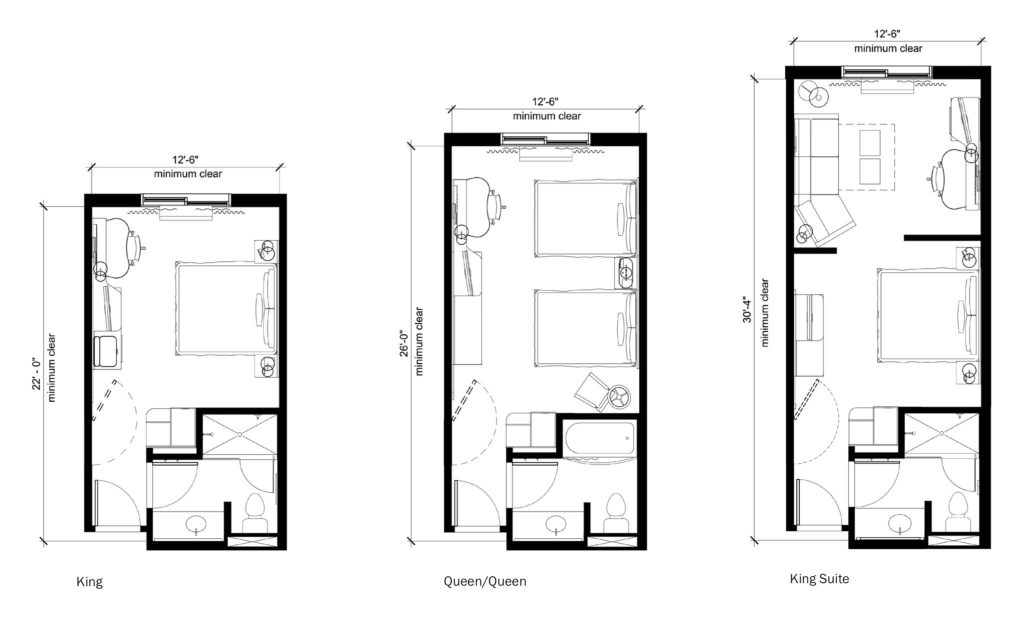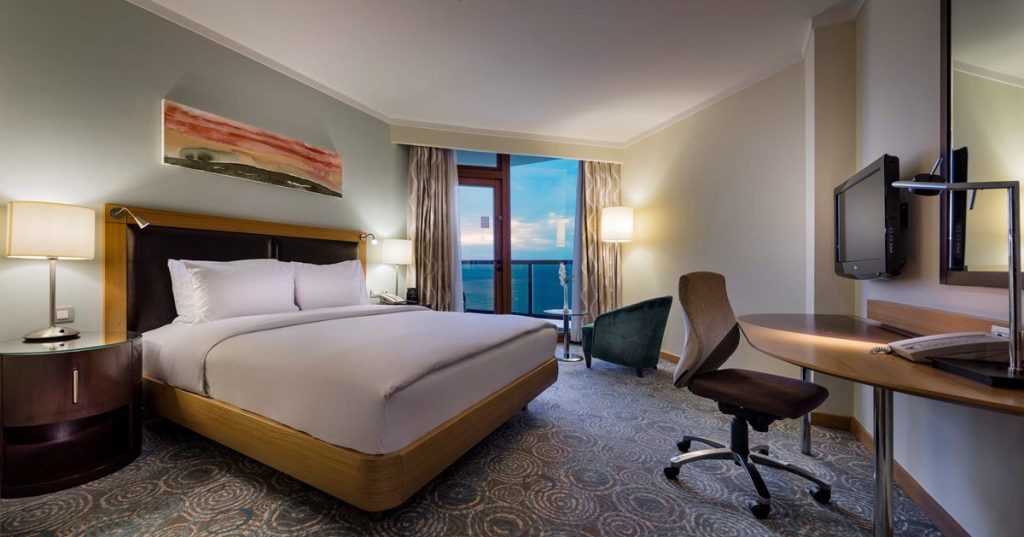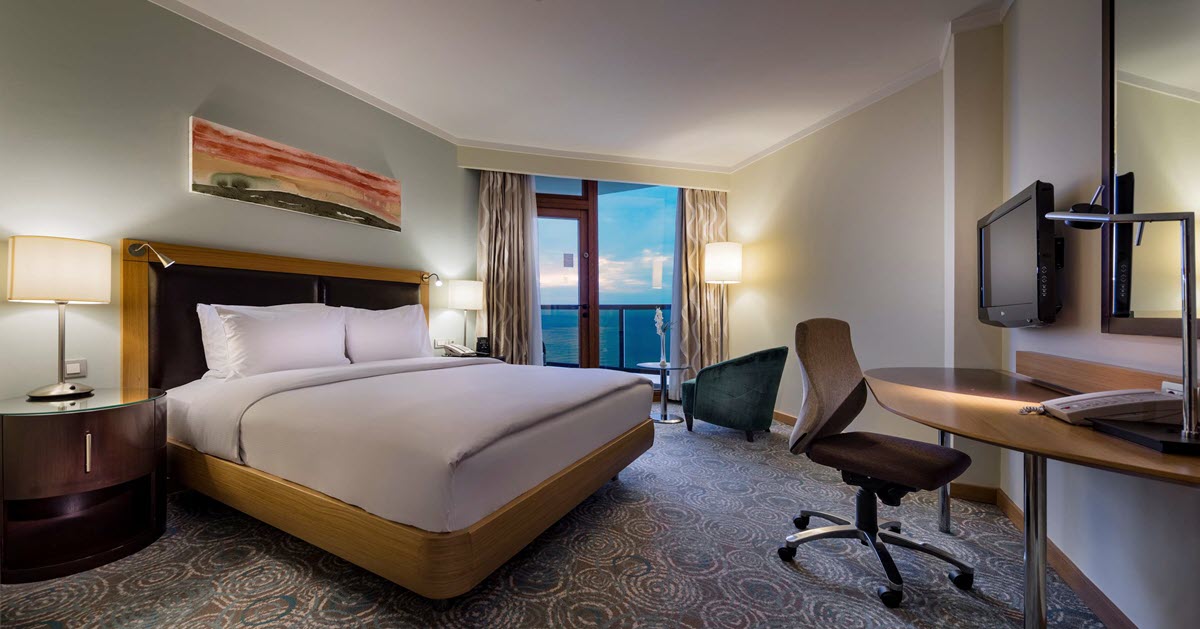Planning your getaway? Room size should be a key factor. What’s the average size of a hotel room? Explore this article for useful info.
Size matters when it comes to hotel rooms. The size of a room can vary with location, type of hotel, and price range. Most standard rooms are 300-400 square feet. This includes the main sleeping area, bathroom, and sometimes a sitting area.
Luxury hotels or suites offer larger rooms – over 400 sq. ft. These have added comforts and amenities, like separate living spaces, kitchenettes, dining spots, and even multiple bedrooms.
The size of a hotel room also differs according to country or region. Hotel rooms in densely populated places like NYC and Tokyo tend to be smaller.
Hotels.com’s 2020 study revealed Europe had the smallest average hotel rooms at 200-250 sq. ft. North America had larger rooms – 350-400 sq. ft.
The Concept of Average Size Hotel Room
Various factors, such as customer preferences, local regulations, and hotel categories, influence the average size of hotel rooms. Luxury hotels, for example, tend to offer bigger accommodations than budget hotels. Where land is limited or pricey, hotels usually have smaller rooms to increase their capacity.
Hotel rooms differ in layout and function, too. Some have separate areas for sleeping, dining, and working. Others have open-plan designs. So, travelers should consider their needs and preferences when booking a room.

Let’s take Jane’s experience in New York City. As a first-time visitor, she booked a budget-friendly hotel. But she was surprised by the small size of the room. The lack of space made it difficult for her to unwind after a long day.
Benefits of knowing the average size of hotel rooms
The average size of hotel rooms can bring many advantages to travelers. Understandably, knowing this info is especially useful for those who prioritize comfort and need plenty of room for their luggage. This helps them make better decisions when booking accommodations while also aiding in planning activities within the room. Furthermore, travelers with special requirements can select a room that meets their needs.
In addition, it reveals regional variations in room sizes. This knowledge is particularly helpful for frequent travelers, who may have certain expectations based on previous experiences. Knowing the average size also helps estimate if additional fees are justified.
Factors that influence the average size of hotel rooms
Location, hotel category, and target market are key factors in deciding room sizes of hotels. Design of the hotel is also important.
For example, urban areas usually have smaller rooms due to limited space. Upscale hotels offer larger rooms compared to budget or economy ones. Hotels targeting families give larger rooms with additional sleeping spaces. Room configuration and layout affect sizes too.
Furthermore, local regulations, land availability, and architectural constraints make an impact on room sizes. In some Asian countries, land is limited and expensive, so hotels are designed with smaller rooms to make use of the space and provide essential amenities.
A couple experienced the influence of room size firsthand. They booked a stay at a boutique hotel known for its contemporary design but were surprised by the small size of their room. However, the clever use of space and minimalist furnishings made their stay comfortable and enjoyable.
Examples of Different Types of Hotel Room Sizes
Hotel room sizes may vary greatly, depending on the room type and brand. This is to give you an idea of what to expect when booking.
| Room Type | Approximate Size (in square feet) |
| Standard Room | 300-400 |
| Deluxe Room | 400-500 |
| Junior Suite | 500-700 |
| Executive Suite | 700-900 |
These are just general ranges. Some hotels may offer smaller or larger rooms. Also, these measurements can vary slightly between hotels.
You may find unique rooms, such as presidential suites or villas, at luxury hotels. These can be over 1000 square feet! They often come with extra amenities and services to give guests a special experience.
Imagine this: once, a couple entered a boutique hotel and were amazed by their suite. The room was huge, with floor-to-ceiling windows and a stunning view. They felt like they were living in a dream. The room size allowed them to really relax and enjoy their stay.
There are hotel rooms for everyone’s preferences and needs. Before booking, check the room size to ensure it meets your expectations and provides comfort.
Tips for selecting the right hotel room size for your needs
Finding the perfect hotel room size is critical for a great stay. Here are some pointers to help you make the right choice:
- Take into account the number of people: If you’re solo, a smaller room will do. But for families or groups, opt for larger rooms or connected suites.
- Look at your comfort needs: If you like lots of space and movement, go for a bigger room with extra seating areas or even a separate living area.
- Check the amenities: Certain hotels offer various room types that cater to special needs, like rooms with kitchenettes for extended stays or rooms with accessible features for disabled guests.
- Set your budget wisely: Bigger rooms often cost more, so assess your budget and prioritize your requirements.
Apart from these tips, note that the size of hotel rooms can differ greatly based on factors like location, hotel category, and cultural preferences. So, before making a reservation, research specific hotels and their room dimensions.

One traveler revealed an interesting story about selecting the right hotel room size. She booked a compact room due to a tight budget but felt cramped the whole time. She realized the need for adequate space for personal comfort, so she now always checks room dimensions and chooses more spacious accommodations whenever possible.
Remember, the right hotel room size can greatly improve your overall experience. So, next time you plan a trip, remember these tips and find a room that perfectly meets your needs.
Common Misconceptions About Hotel Room Size
Many have wrong ideas about hotel room size. They often think it’s all small and cramped, but that’s not true! Here’s what we know:
- Rooms aren’t always small: Though some are, many offer ample space for guests to relax.
- Not all rooms are the same size: There are many options, from single rooms to luxurious suites.
- Bigger doesn’t always mean more expensive: You don’t have to pay high prices for a bigger room.
- Room size matters: It affects your overall comfort and experience.
Factors like location and type of hotel can affect room size. Boutique hotels usually have smaller rooms, while resorts may offer larger ones. It’s important to think about what you need. In 2019, Hotels.com found that the average size of a hotel room in the US is 330 square feet.
Conclusion
When it comes to hotel room size, there are many elements to consider. Location, class, amenities, and price all affect the size. High-end hotels usually have large rooms, while budget hotels have smaller, more functional ones. Boutique hotels prioritize uniqueness, so their rooms are often cozy but stylish. Chain hotels have standardized sizes.
Take this story as an example. A traveler checked into a boutique hotel with a small but well-designed room. Despite its size, it had smart storage and modern amenities. The traveler realized that sometimes, it’s not about the square footage but how the space is used.

Meet Kein, a young solo adventurer traversing the globe, seeking out the most thrilling experiences. Through this blog, he documents his daring journeys, offering a blend of adventure tales and invaluable tips for like-minded explorers.







